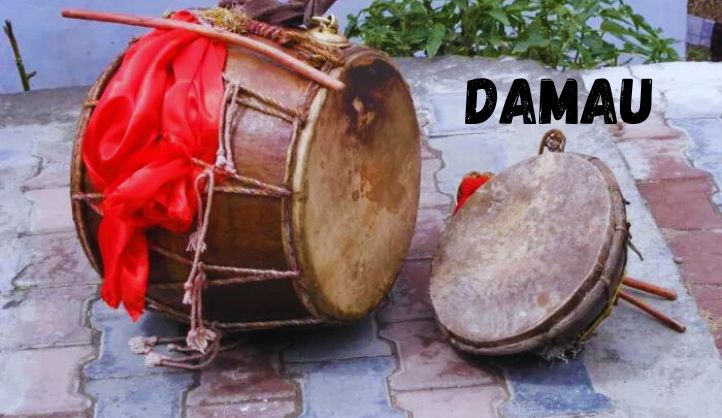Uttarakhand, nestled in the lap of the Himalayas, is not only renowned for its stunning landscapes and rich cultural heritage but also for its traditional music, which holds a special place in the hearts of its people. One of the most fascinating aspects of this musical heritage is the use of traditional instruments, particularly the Damau.
A Glimpse into the Musical Heritage of Uttarakhand
Uttarakhand, often called “Devbhumi” or the “Land of the Gods,” has a diverse cultural tapestry woven with traditions, rituals, and music. The music of Uttarakhand is deeply rooted in its folklore, religious practices, and daily life. It serves as a medium to express joy, sorrow, devotion, and communal harmony.
The Damau: An Integral Part of Uttarakhand’s Musical Tradition
The Damau is one of the most prominent traditional instruments in Uttarakhand, known for its distinct sound and historical significance. It is a percussion instrument, akin to a drum, and is often played in conjunction with other traditional instruments such as the Dhol, Hurka, and Daur. The Damau is made from locally sourced materials, reflecting the resourcefulness and ingenuity of the people of Uttarakhand.
Historical Significance and Origins
The origins of the Damau can be traced back to ancient times when it was used in various cultural and religious ceremonies. It is believed that the instrument has been a part of Uttarakhand’s musical tradition for centuries, playing a crucial role in festivals, weddings, and other communal gatherings. The rhythmic beats of the Damau have been a source of inspiration for folk dances and songs that celebrate the region’s natural beauty and cultural heritage.
Construction and Design
The Damau is typically made from wood and animal hide. The body of the drum is carved out of a single piece of wood, usually from trees such as mango or jackfruit, which are known for their durability and resonance. The drumhead is made from goat or buffalo hide, tightly stretched over the wooden frame. The instrument is played using wooden sticks, which produce a deep and resonant sound when struck against the drumhead.
Playing Techniques and Musical Styles
Playing the Damau requires skill and precision. The instrument is usually played in a seated position, with the musician using both hands to strike the drumhead with the sticks. The beats are rhythmic and repetitive, creating a hypnotic and entrancing sound that complements the melodies of other traditional instruments.
The Damau is often used in various musical styles, including folk songs, religious hymns, and dance music. It is an essential component of traditional dance forms such as the Chholiya, which is performed during weddings and other celebratory occasions. The rhythmic patterns of the Damau provide the foundation for the dancers’ movements, enhancing the overall performance and creating a captivating experience for the audience.
Some other traditional instruments of Uttarakhand
1. Dhol
The Dhol is a double-headed drum that is widely used in Uttarakhand’s folk music. It is played with sticks, producing a loud and rhythmic sound that is essential for various traditional dances and ceremonies. The Dhol is often played in conjunction with the Damau, creating a powerful and captivating musical experience.
2. Turri
The Turri is a traditional wind instrument made from copper or brass. It resembles a long trumpet and produces a resonant, trumpet-like sound. The Turri is commonly used in religious ceremonies, processions, and folk dances, adding a melodic layer to the ensemble.
3. Bina
The Bina, also known as the Bhana, is a type of traditional flute made from bamboo. It produces a soft and melodious sound, often used to accompany folk songs and dances. The Bina is known for its ability to evoke the serene and tranquil essence of Uttarakhand’s natural landscapes.
4. Ransingha
The Ransingha is a traditional wind instrument made from metal, often brass or copper. It has a curved, horn-like shape and produces a deep, resonant sound. The Ransingha is typically played during religious ceremonies, processions, and festive occasions, symbolizing the call to gather and celebrate.
5. Hudka
The Hudka is a small, handheld drum that is an integral part of Uttarakhand’s folk music. It is made from wood and animal hide and is played with the hands. The Hudka is particularly popular in the Kumaon region and is used to accompany folk dances and storytelling performances.
6. Thali
The Thali is a metallic percussion instrument, essentially a large, flat plate made of brass or other metals. It is struck with a stick or mallet to produce a sharp, resonant sound. The Thali is often used in religious and ceremonial music, as well as in folk dances.
Cultural Significance and Preservation
The Damau is more than just a musical instrument; it is a symbol of Uttarakhand’s cultural identity and heritage. It embodies the spirit and traditions of the region, connecting the present generation with their ancestors’ way of life. Efforts are being made to preserve and promote the traditional music of Uttarakhand, including the art of playing the Damau. Various cultural festivals, workshops, and music academies are dedicated to keeping this ancient tradition alive and passing it on to future generations.
Conclusion
The Damau traditional instruments of Uttarakhand are a testament to the region’s rich cultural heritage and musical prowess. The deep, resonant beats of the Damau have echoed through the valleys and mountains of Uttarakhand for centuries, creating a timeless connection between the people and their land. As we celebrate and preserve these traditions, we ensure that the enchanting sounds of Uttarakhand continue to resonate for generations to come.
FAQs about Damau Traditional Instruments of Uttarakhand
1. What is the Damau?
The Damau is a traditional percussion instrument from Uttarakhand, India. It is similar to a drum and is known for its deep, resonant sound. The Damau is an integral part of the region’s musical heritage and is used in various cultural and religious ceremonies.
2. How is the Damau made?
The Damau is typically made from wood and animal hide. The body of the drum is carved from a single piece of wood, usually from trees like mango or jackfruit. The drumhead is made from goat or buffalo hide, which is tightly stretched over the wooden frame. Wooden sticks are used to play the instrument.
3. What is the historical significance of the Damau?
The Damau has been a part of Uttarakhand’s musical tradition for centuries. It has played a crucial role in festivals, weddings, and other communal gatherings. The rhythmic beats of the Damau have inspired folk dances and songs, celebrating the region’s natural beauty and cultural heritage.
4. In what types of events is the Damau typically played?
The Damau is played in a variety of events, including festivals, weddings, and religious ceremonies. It is also a key component of traditional dance forms such as the Chholiya, performed during celebratory occasions.
5. How is the Damau played?
Playing the Damau requires skill and precision. The musician usually sits while playing, using both hands to strike the drumhead with wooden sticks. The beats are rhythmic and repetitive, creating an entrancing sound that complements other traditional instruments.





